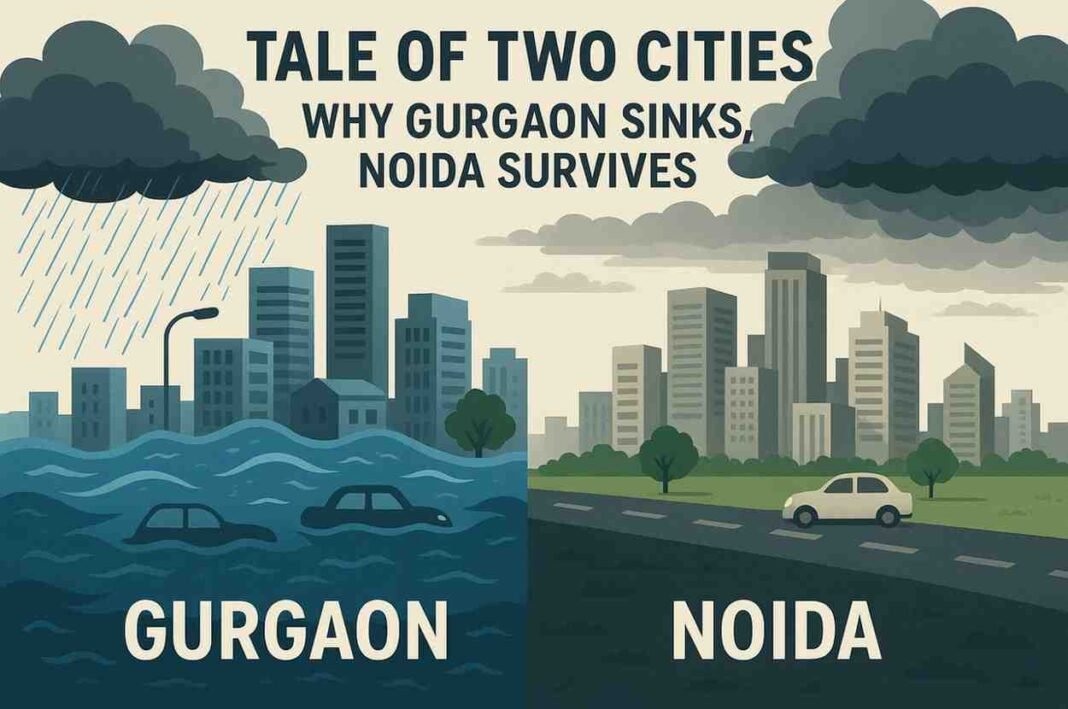Gurgaon’s Recurring Monsoon Nightmare
Every year, the arrival of the monsoon brings with it familiar scenes in Gurgaon: waterlogged intersections, cars stranded on arterial roads, and commuters stuck for hours. The situation has almost become routine, sparking questions about why India’s leading corporate hub fails to cope with heavy rain. Experts say the answer lies in its planning—or rather, the lack of it. Unlike its neighbor Noida, which was designed as a planned township, Gurgaon grew organically and haphazardly, leaving infrastructure unable to match the pace of urbanization.
Road Networks That Fail the City
One of the biggest reasons behind Gurgaon’s recurring gridlock lies in its road network. The city developed largely around radial routes such as NH-48, Sohna Road, and Golf Course Road, which carry the bulk of daily traffic. When rainwater accumulates, these choke points quickly become impassable, forcing vehicles to crawl. In contrast, Noida benefits from a sector-based grid layout, where wide avenues are supported by parallel arterial roads and service lanes. This grid system allows traffic to be diverted when a particular stretch gets flooded, significantly reducing the ripple effect of congestion.
Drainage: The Weakest Link in Gurgaon
Perhaps the most striking difference between the two cities is stormwater management. In Gurgaon, drainage channels have either been encroached upon or concretized, cutting off natural pathways for rainwater. In many areas, stormwater drains are incomplete or clogged, causing even moderate showers to turn roads into rivers. On the other hand, Noida was built with integrated stormwater channels that feed into the Yamuna floodplains. The Noida Authority also undertakes regular desilting, ensuring that the drainage system remains functional during peak monsoon months. Green belts and sector parks further act as catchment zones, absorbing excess water.
Urbanization Without Support Infrastructure
The speed and style of Gurgaon’s growth also add to its woes. The city experienced a construction boom in the 1990s and 2000s, driven by real estate developers and corporate offices. This rapid vertical growth—luxury condominiums, glass towers, and malls—was not matched with commensurate public infrastructure. Developers often built internal drainage and road systems, but external connectivity was left to fragmented civic bodies. Noida, in comparison, has a more balanced urban design, with residential, industrial, and institutional zones planned together. High-rise clusters are better distributed, preventing localized overloading of civic systems.
Governance: One Authority Versus Many
Another crucial difference is governance. In Noida, the Noida Authority functions as a single-window civic body, overseeing planning, roads, drainage, and maintenance. This unified structure allows for quicker decision-making and coordinated responses during emergencies. Gurgaon, however, suffers from overlapping jurisdictions. The Municipal Corporation of Gurugram (MCG), Haryana Urban Development Authority (HUDA), Gurugram Metropolitan Development Authority (GMDA), and National Highways Authority of India (NHAI) all manage different aspects of the city, often passing the blame when things go wrong. This fragmentation delays long-term solutions and keeps the city vulnerable year after year.
Current Measures and the Road Ahead
Authorities in both cities claim to be working on improvements. Noida has adopted smart drainage mapping, emphasized rainwater harvesting, and is constructing new underpasses to ease congestion. Gurgaon’s GMDA has announced a drainage masterplan and initiated desilting drives before the monsoon. However, implementation remains patchy, and residents often complain that promises outpace delivery. Urban experts suggest that Gurgaon needs systemic reforms—restoring natural drainage channels, enforcing stricter development controls, and creating redundancy in its transport network—to avoid being paralyzed every time the skies open.
Bottom Line
While both Gurgaon and Noida face heavy rains, their outcomes differ starkly because of how they were built. Noida’s resilience stems from its origins as a planned township, with integrated infrastructure that anticipates seasonal stress. Gurgaon, by contrast, is still struggling with retrofitted solutions to problems created by unchecked growth. Unless Gurgaon learns from Noida’s model and undertakes structural reforms, the monsoon gridlock will remain an annual spectacle.








